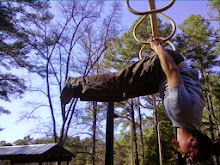 Excerpt from a UC Berkeley study back in 2006...
Excerpt from a UC Berkeley study back in 2006...If you "feel the burn," you need to bulk up your mitochondria
By Robert Sanders, Media Relations | 19 April 2006
BERKELEY – In the lore of marathoners and extreme athletes, lactic acid is poison, a waste product that builds up in the muscles and leads to muscle fatigue, reduced performance and pain.
Some 30 years of research at the University of California, Berkeley, however, tells a different story: Lactic acid can be your friend.
Coaches and athletes don't realize it, says exercise physiologist George Brooks, UC Berkeley professor of integrative biology, but endurance training teaches the body to efficiently use lactic acid as a source of fuel on par with the carbohydrates stored in muscle tissue and the sugar in blood. Efficient use of lactic acid, or lactate, not only prevents lactate build-up, but ekes out more energy from the body's fuel. In a paper in press for the American Journal of Physiology - Endocrinology and Metabolism, published online in January, Brooks and colleagues Takeshi Hashimoto and Rajaa Hussien in UC Berkeley's Exercise Physiology Laboratory add one of the last puzzle pieces to the lactate story and also link for the first time two metabolic cycles - oxygen-based aerobic metabolism and oxygen-free anaerobic metabolism - previously thought distinct.
"This is a fundamental change in how people think about metabolism," Brooks said. "This shows us how lactate is the link between oxidative and glycolytic, or anaerobic, metabolism."
He and his UC Berkeley colleagues found that muscle cells use carbohydrates anaerobically for energy, producing lactate as a byproduct, but then burn the lactate with oxygen to create far more energy. The first process, called the glycolytic pathway, dominates during normal exertion, and the lactate seeps out of the muscle cells into the blood to be used elsewhere. During intense exercise, however, the second ramps up to oxidatively remove the rapidly accumulating lactate and create more energy.
Training helps people get rid of the lactic acid before it can build to the point where it causes muscle fatigue, and at the cellular level, Brooks said, training means growing the mitochondria in muscle cells. The mitochondria - often called the powerhouse of the cell - is where lactate is burned for energy.
"The world's best athletes stay competitive by interval training," Brooks said, referring to repeated short, but intense, bouts of exercise. "The intense exercise generates big lactate loads, and the body adapts by building up mitochondria to clear lactic acid quickly. If you use it up, it doesn't accumulate."
To move, muscles need energy in the form of ATP, adenosine triphosphate. Most people think glucose, a sugar, supplies this energy, but during intense exercise, it's too little and too slow as an energy source, forcing muscles to rely on glycogen, a carbohydrate stored inside muscle cells. For both fuels, the basic chemical reactions producing ATP and generating lactate comprise the glycolytic pathway, often called anaerobic metabolism because no oxygen is needed. This pathway was thought to be separate from the oxygen-based oxidative pathway, sometimes called aerobic metabolism, used to burn lactate and other fuels in the body's tissues.
Experiments with dead frogs in the 1920s seemed to show that lactate build-up eventually causes muscles to stop working. But Brooks in the 1980s and '90s showed that in living, breathing animals, the lactate moves out of muscle cells into the blood and travels to various organs, including the liver, where it is burned with oxygen to make ATP. The heart even prefers lactate as a fuel, Brooks found.
Brooks always suspected, however, that the muscle cell itself could reuse lactate, and in experiments over the past 10 years he found evidence that lactate is burned inside the mitochondria, an interconnected network of tubes, like a plumbing system, that reaches throughout the cell cytoplasm.
In 1999, for example, he showed that endurance training reduces blood levels of lactate, even while cells continue to produce the same amount of lactate. This implied that, somehow, cells adapt during training to put out less waste product. He postulated an "intracellular lactate shuttle" that transports lactate from the cytoplasm, where lactate is produced, through the mitochondrial membrane into the interior of the mitochondria, where lactate is burned. In 2000, he showed that endurance training increased the number of lactate transporter molecules in mitochondria, evidently to speed uptake of lactate from the cytoplasm into the mitochondria for burning.
The new paper and a second paper to appear soon finally provide direct evidence for the hypothesized connection between the transporter molecules - the lactate shuttle - and the enzymes that burn lactate. In fact, the cellular mitochondrial network, or reticulum, has a complex of proteins that allow the uptake and oxidation, or burning, of lactic acid.
"This experiment is the clincher, proving that lactate is the link between glycolytic metabolism, which breaks down carbohydrates, and oxidative metabolism, which uses oxygen to break down various fuels," Brooks said.
Post-doctoral researcher Takeshi Hashimoto and staff research associate Rajaa Hussien established this by labeling and showing colocalization of three critical pieces of the lactate pathway: the lactate transporter protein; the enzyme lactate dehydrogenase, which catalyzes the first step in the conversion of lactate into energy; and mitochondrial cytochrome oxidase, the protein complex where oxygen is used. Peering at skeletal muscle cells through a confocal microscope, the two scientists saw these proteins sitting together inside the mitochondria, attached to the mitochondrial membrane, proving that the "intracellular lactate shuttle" is directly connected to the enzymes in the mitochondria that burn lactate with oxygen.
"Our findings can help athletes and trainers design training regimens and also avoid overtraining, which can kill muscle cells," Brooks said.Dr Len Kravitz from New Mexico State was talking about this 'shuttle' back in '03 and was ENTHUSIASTICALLY talking about the upcoming research about it. Boy was he right!!Engage and attack...

.jpg)




